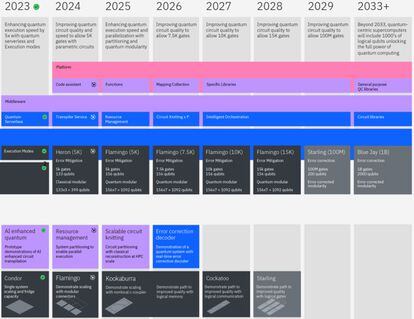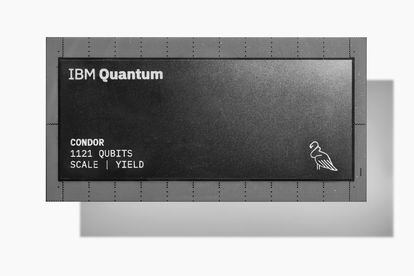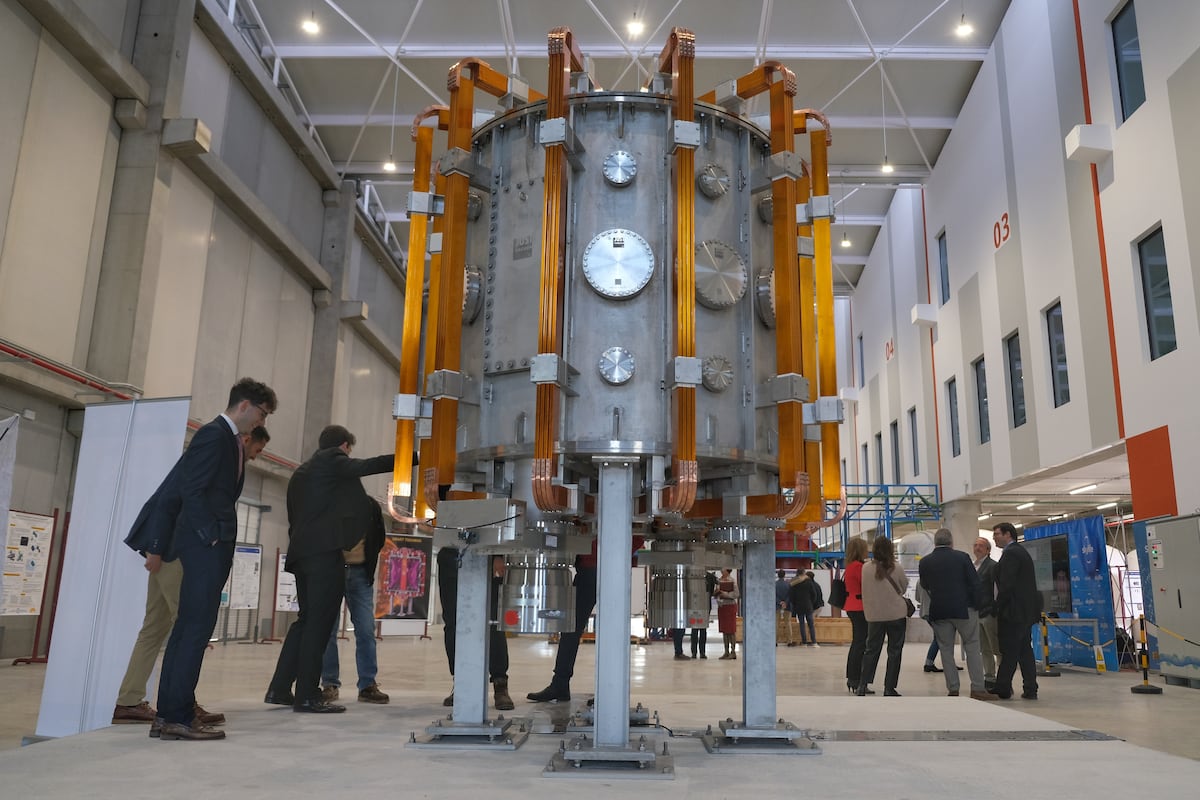Quantum computing is not just a matter of qubits, the basic unit of information. The key to this technology is the combination of systems that allow us to build a useful and fault-tolerant computer. The multinational IBM announced this Monday a fundamental step in this regard by presenting three advances: a 1,121 qubit processor called Cóndor (the largest known); Heron, a 133-qubit chip developed for interconnection and based on an architecture known as “tunable coupler”; and a new System Two, a modular and flexible system for multiple combinations of these processors with quantum and classical communication links. These advances, together with the new error mitigation and correction formulas, anticipate what Darío Gil, vice president of IBM and director of the research division (IBM Research), describes as “the new era of quantum utility,” which could lead to , according to its forecasts, in a basically quantum supercomputer, but with classical systems and with modular error correction in 2033.
IBM’s latest developments have blown up the multinational’s own roadmap, which it has fulfilled until now with mathematical precision, to go further and sooner than expected to “unlocking the full power of quantum computing.” , according to the new technological path presented this Monday.

Overcoming errors, in the words of Jian-Wei Pan, a physicist at the University of Science and Technology of China, “is one of the great challenges for human beings.” Failures are generated by any interaction with the environment (noise, waves or temperature, for example) and cause the superposition of states (the physical property that allows a particle to be in position A and B at the same time) to degrade. until it becomes useless. This superposition is what allows an exponential capacity of quantum computing compared to classical binary, which is limited to the 0 or 1 of the bit. Thus, if two bits can store one number, two qubits store four, and ten qubits can have 1,024 simultaneous states.
To reach this goal of useful and tolerant systems, IBM believes it has found the doors that can allow it and that are based on advances in processors, their interconnection systems to allow robust computing, and mitigation and correction. of errors.

The unique capacity increase has been achieved by IBM again. “The Condor flies,” Gil jokes at the milestone of the new quantum processor that succeeds the Osprey, presented last year with 433 qubits, capable of representing a number of states greater than the number of atoms in the observable universe. But almost tripling the processor capacity is not the only thing achieved. “Many things have happened this year simultaneously,” explains Gil.
The main achievement is that IBM believes that it is no longer essential to continue increasing the capacity of a single processor, but that practical quantum computing can be achieved with another method. “We are going to do it through modularity, with many chips connected to each other in such a way that we can create the supercomputer,” says Gil.

These chips, which would be like the pieces of a construction set, are now the 133-qubit IBM Quantum Heron, created from a new architecture called tunable coupler. This engineering enables quantum information platforms of greater size and functionality. “Heron can be combined modularly and incorporate classic communication to accelerate workflows. With the tunable coupler We can adjust the frequency of the qubits and get a much better processor than the previous one,” explains Gil. This architecture is complemented by 4K cryo-CMOS, semi-autonomous, low-power and “fingernail-sized” qubit state controllers.
“Heron is our best performance quantum processor to date. It represents an improvement of up to five times compared to the flagship device: the Eagle,” adds Matthias Steffen, head of the company’s quantum architecture and processor technologies.
The basis of the interconnection of Heron chips is the new generation of System Two, the system designed to modularly and flexibly combine multiple processors into a single system with communication links. This network is the basic component of quantum supercomputing, as it allows computing potential to be scaled without having to progress indefinitely on the singular capacity of a single processor.
“System Two will enable new generations of processors focused on quantum technology, with a fully scalable and modular core infrastructure that will allow circuits to be executed like never before,” says Steffen.
/cloudfront-eu-central-1.images.arcpublishing.com/prisa/OAFGG5GN7BAG5BJ4STBABSVLAM.jpg)
The new model has led to rethinking future developments. Gil affirms that “all subsequent generations will be based on him.” “We are convinced that we do not need to further increase the number of qubits per processor unit. The future is going to be hundreds and thousands of processors, each smaller than 1,000 qubits, connected to each other,” he says.
The key element that opened the doors to this new path was the research published in Nature and which demonstrated that an IBM processor of only 127 qubits is capable of measuring expected values in physics operations beyond the capabilities of the best current classical computational methods. “It allows us to enter the era that we have called quantum utility, in which calculations can now be made in a much more efficient and robust way than can be done with any type of simulator or with any type of classical computing” says Gil.
Katie Pizzolato, head of quantum algorithms and scientific partners at the company, believes this is a disruptive moment: “It was the first time a quantum computer produced precise values at a scale that was outside the reach of classical brute force computing.” and the response since then has been exactly what we expected; Since this article we have seen many people publishing research that uses quantum as a tool.”
It is no longer just about Qiskit, an environment of classical and quantum systems that allows solutions to noise to be brought to programming and makes it easier for users to incorporate the most advanced computing. “Now we have broken the barrier of more than 100 qubits with sufficient quality,” highlights the Spanish manager in reference to the research of Nature. And he announces: “Combined with error mitigation, they will enable a scientific explosion.”
Jay Gambetta, vice president of IBM Quantum, highlights that this program development will be favored by artificial intelligence: “All the power of quantum computing will be driven by generative AI, which will simplify the developer experience.”
“There are many problems to face and nature knows how, but it doesn’t tell us,” summarizes Stefan Woerner, director of Quantum Computational Science at IBM’s headquarters in Zurich (Switzerland). The scientist affirms that the final objective is to reach quantum computing based on three criteria: that it is more efficient, cheaper and precise. The model demonstrated in Natureaccording to him, has been “crucial” to advance on this path.
“It will be very strange for any major cloud platform to not have quantum computing in 2030. This is going to be more impactful than artificial intelligence and current supercomputers,” believes Christian Weedbrook, director of Xanadu Quantum Technologies. “Quantum computing will change the relationships between people, technology and work,” adds Soney Trent, founder and president of the technology company Bulls Run Group.
Quantum research continues and all contribute to the development of this technology. Researchers from the Argonne National Laboratory of the United States Department of Energy (DOE), the University of Chicago and the University of Cambridge have created more controllable qubits from diamond that can operate with significantly reduced equipment and expense, as published in Physical Review. “Our technique allows us to dramatically raise the operating temperature of these systems and greatly reduces the resources to operate them,” says Alex High, an assistant professor at the University of California Pritzker School of Molecular Engineering, whose lab led the study.
You can follow EL PAÍS Technology in Facebook and x or sign up here to receive our weekly newsletter.
Subscribe to continue reading
Read without limits
_








